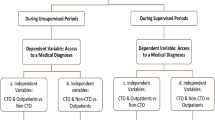Abstract
The long-term effect of outpatient commitment on service use was evaluated in 81 patients with serious and persistent mental illness. An increased number of outpatient visits and a decreased number of hospital admissions, total hospital days, and lengths of stay were observed during commitment periods of greater than 1 year relative to levels of use in the same patients over the 12-month period preceding commitment. This study provides support that outpatient commitment improves compliance with outpatient treatment and reduces hospital use in patients who are on outpatient commitment to a single treatment agency for periods up to 5 years.
Similar content being viewed by others
REFERENCES
Draine, J.(1997).Conceptualizing services research on outpatient commitment.Journal of Mental Health Administration,24, 306–315.
Fernandez, G.A., & Nygard, S.(1990).Impact of involuntary outpatient commitment on the revolving door syndrome in North Carolina.Hospital & Community Psychiatry,41, 1001–1004.
Geller, J.L.(1990).Clinical guidelines for the use of involuntary outpatient treatment.Hospital & Community Psychiatry,41, 749–755.
Geller, J.L., Grudzinskas, A.J., McDermeit, M., Fisher, W.H., & Lawlor, T.(1998).The efficacy of involuntary outpatient treatment in Massachusetts.Administration and Policy in Mental Health,25, 271–285.
Goodpastor, W.A., & Hare, B.K.(1991) Factors associated with multiple readmissions to an urban public psychiatric hospital.Hospital & Community Psychiatry,42, 85–87.
Green, J.H.(1991).Frequent rehospitalization and noncompliance with treatment.Hospital & Community Psychiatry,39, 963–966.
Hiday, V.A., & Goodman, R.R.(1982).The least restrictive alternative to involuntary hospitalization, outpatient commitment:Its use and effectiveness. Joumal of Psychiatry and the Law,10, 81–96.
Hiday, V.A., & Scheid-Cook, T.L.(1989).A follow-up of chronic patients committed to outpatient treatment.Hospital and Community Psychiatry,40, 52–59.
Munetz, M.R., Grande, T., Kleist, J., & Peterson, G.A.(1996).The effectiveness of outpatient civil commitment.Psychiatric Services,47, 1251–1253.
Sensky, T., Hughes, T., & Hirsch, S.(1991).Compulsory psychiatric treatment in the community.II: A controlled study of patients whom psychiatrists would recommend for compulsory treatment in the community.British Journal of Psychiatry,158, 792–804.
Swanson, J.W., Swartz, M.S., George, L.K., Burns, B.J., Hiday, V.A., Borum, R., & Wagner, H.R.(1997).Interpreting the effectiveness of involuntary outpatient commitment:A conceptual model, Journal of the American Academy of Psychiatry and the Law, 25(1), 5–16.
Swartz, M.S., Burns, B.J., Hiday, V.A., George, L.K., Swanson, J., & Wagner, H.R.(1995).New directions in research on involuntary outpatient commitment.Psychiatric Services,46, 381–385.
Torrey, E.F., & Kaplan, RJ.(1995).A national survey of the use of outpatient commitment.Psychiatric Services,46, 778–784.
Zanni, G., & deVeau, L.(1986).Inpatient stays before and after outpatient commitment.Hospital E Community Psychiatry,37, 941–942.
Author information
Authors and Affiliations
Rights and permissions
About this article
Cite this article
Rohland, B.M., Rohrer, J.E. & Richards, C.C. The Long-Term Effect of Outpatient Commitment on Service Use. Adm Policy Ment Health 27, 383–394 (2000). https://doi.org/10.1023/A:1021338208677
Issue Date:
DOI: https://doi.org/10.1023/A:1021338208677



